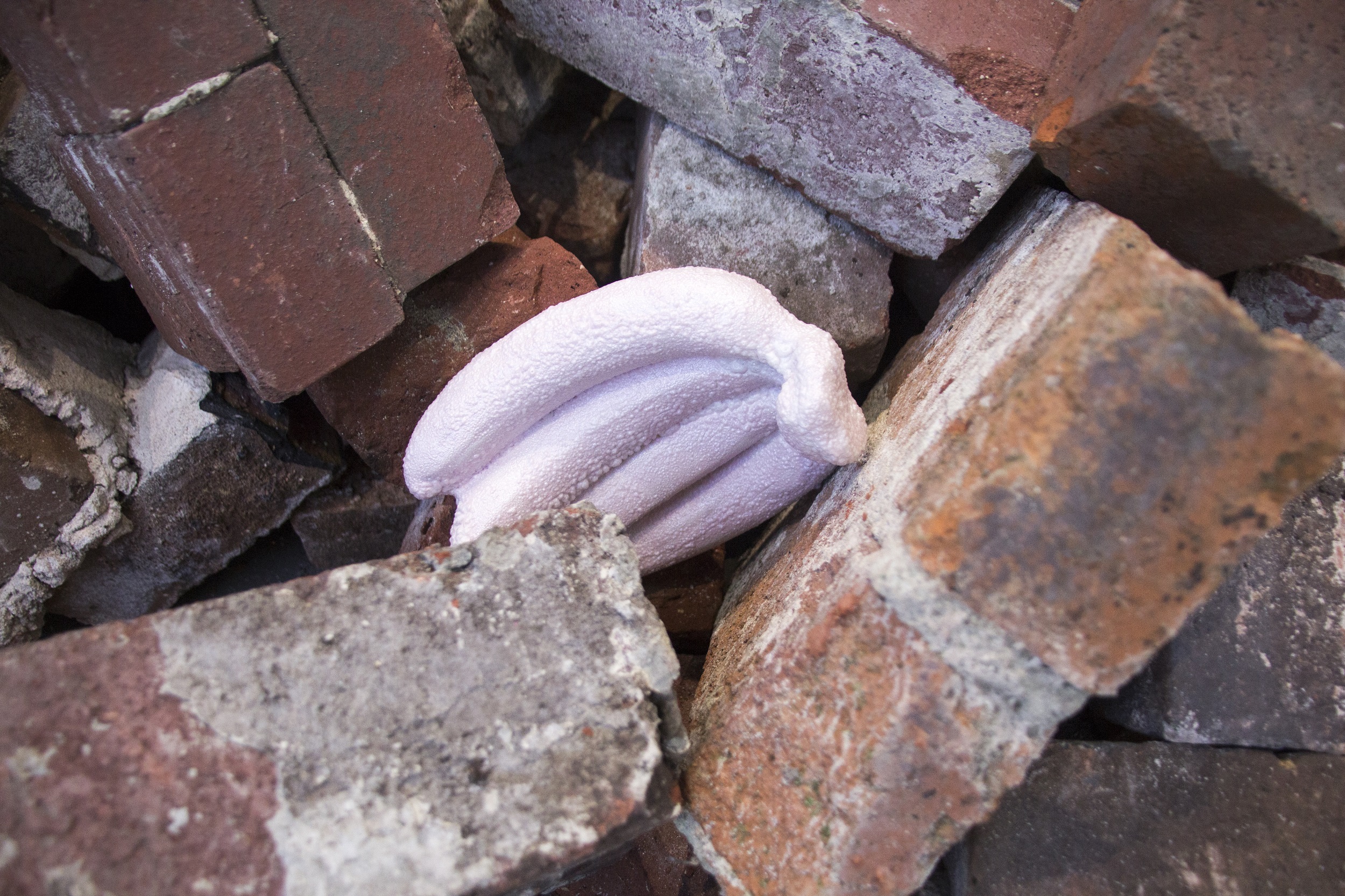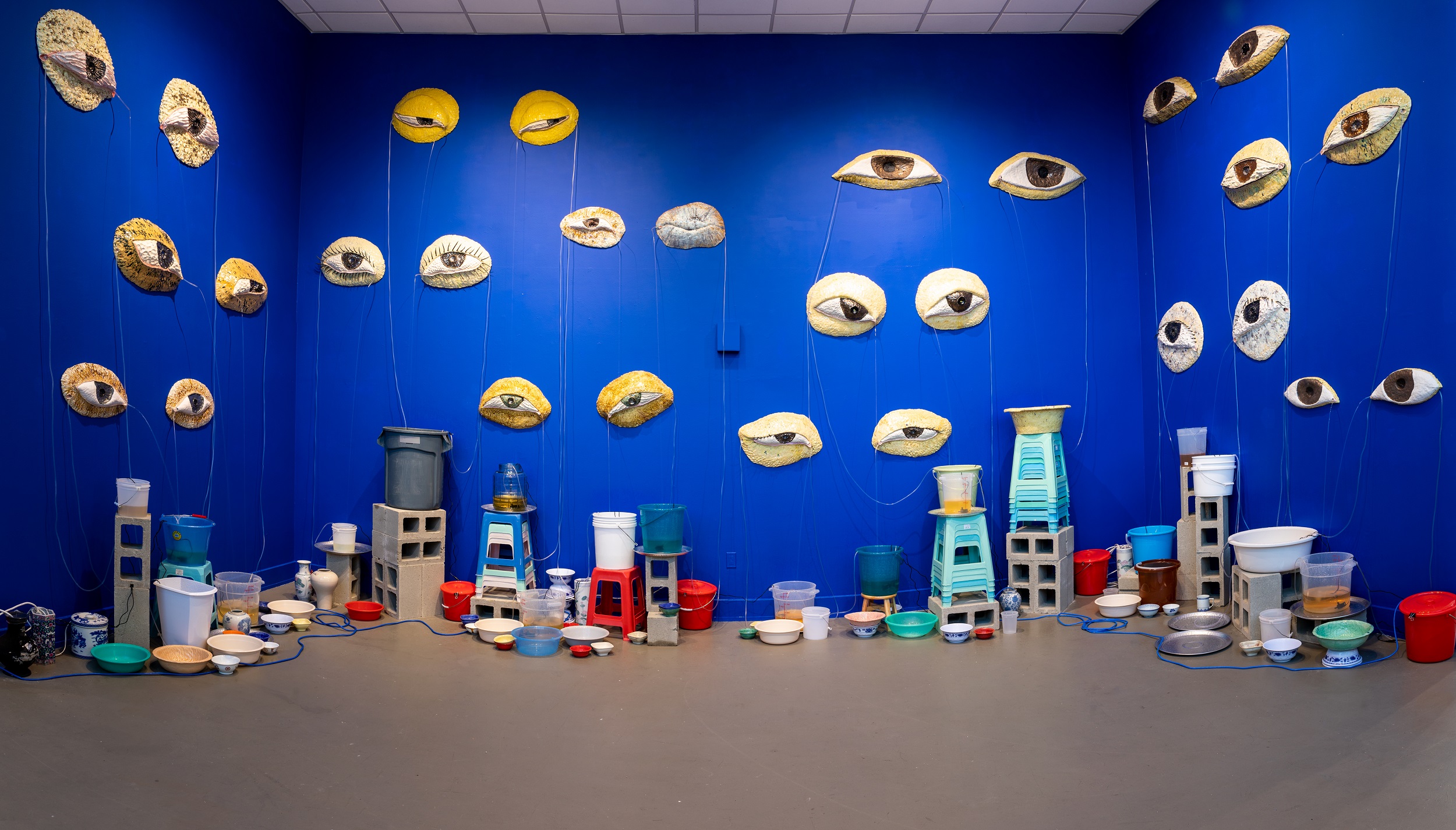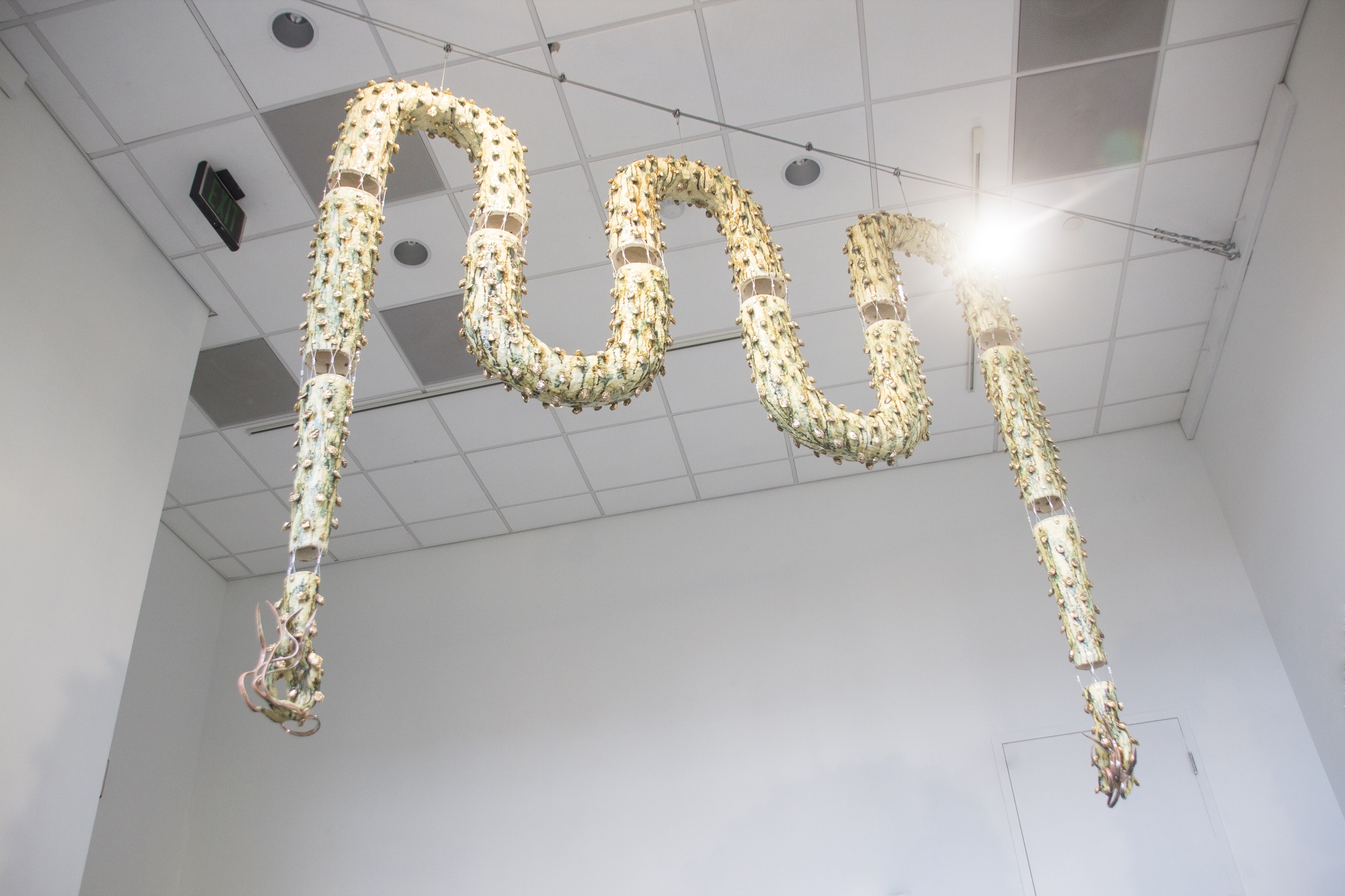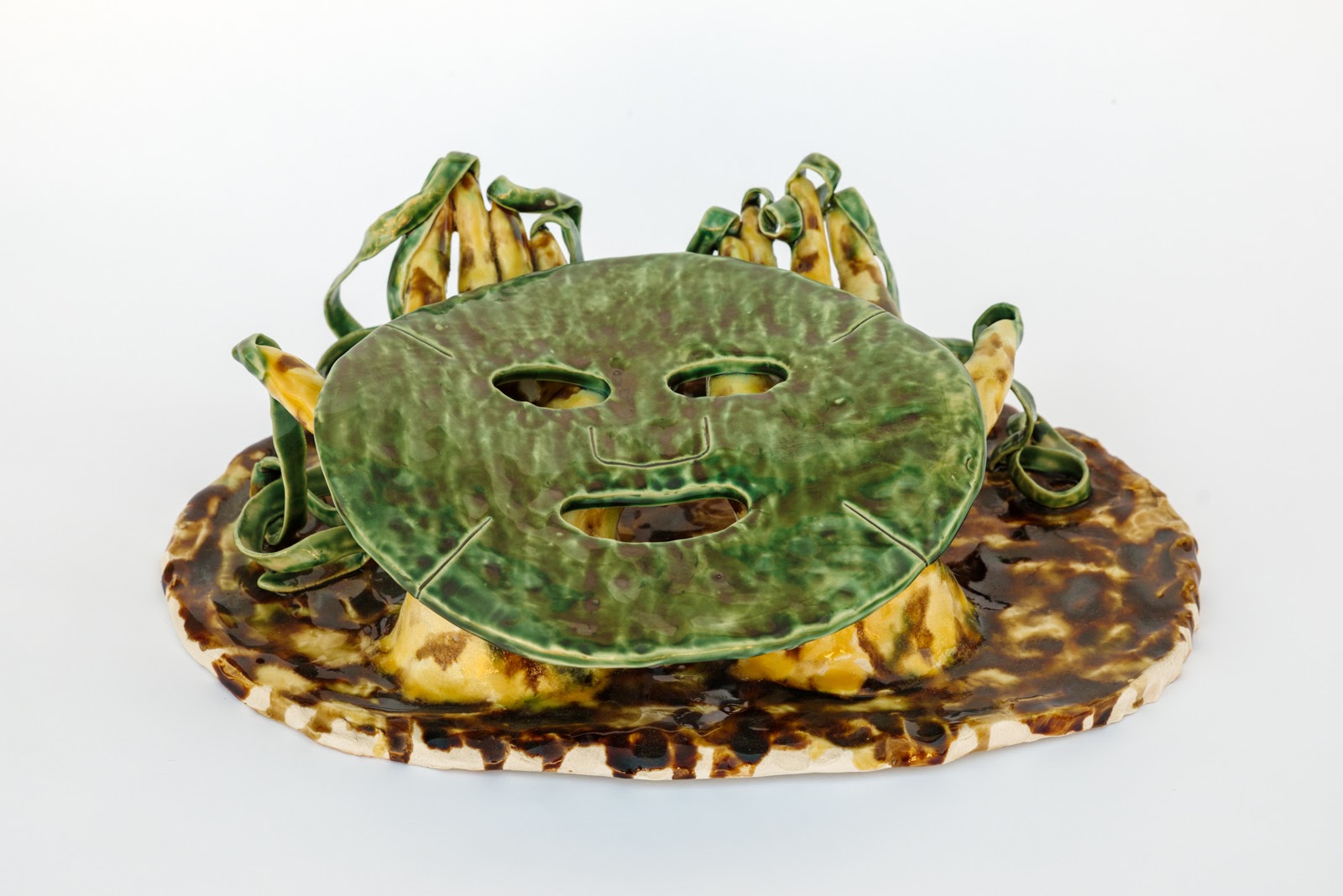Cathy Lu: Interior Garden
PDF: Morris, review of Cathy Lu
Curated by: Hoi Leung
Exhibition Schedule: Chinese Cultural Center of San Francisco, January 20–December 17, 2022
A striking pair of colossal ceramic eyes marks the entrance to Cathy Lu’s solo exhibition Interior Garden, commissioned by the Chinese Culture Center (CCC) of San Francisco. The eyes are shocking not because they peer out from behind the center’s circular moon gate but because they do so from within the Hilton San Francisco Financial District Hotel, located in the city’s iconic Chinatown neighborhood. Ensconced on the third floor of the Hilton, the CCC works, from inside this bastion of tourism, to give the Chinese community and greater diaspora more visibility through free educational programs, events, and exhibitions for long-term residents and outside visitors alike.1 This exhibition was developed over the past two years of the pandemic—a period of isolation, political scapegoating, and a rise in anti-Asian attacks. Thus, it is not surprising that Lu—an American artist of Chinese and Taiwanese descent—drew inspiration from another retreat-like setting: the Chinese garden. By echoing the structure of a Chinese garden, Interior Garden presents four cohesive installations, calibrated to the site, that grapple with themes of Asian American identity and tenets of the “American Dream.”
While interest in matters of identity and identification are well-worn topics in Asian American art histories and exhibitions, recent group shows of contemporary ceramics on the West Coast, such as The Body, The Object, The Other (2020) at the Craft Contemporary in Los Angeles and Belonging (2022) at the Crocker Art Museum in Sacramento, signal new narrative potentials for clay—a medium sidelined in modern histories of art for its associations with the domestic and decorative—to express expanding ideas of self and community. While Lu’s primary material is clay, her artistic practice is resolutely syncretic, often combining the aesthetics of craftwork, sculpture, and industry with themes that favor complex transnational narratives, subjective experiences, and emotions.
The moon gate is the first of several garden elements that Lu draws on to transform the CCC’s four light-drenched and interconnected galleries into a space that, according to curator Hoi Leung, promotes “contemplation and reconciliation.”2 Yet, the stereotypical elements of upper-class Chinese gardens—stones, waterfalls, ponds, flora, and “borrowed scenery”—are quickly challenged, if not annihilated entirely, in the introductory room.3 For example, directly below the wall text, “rocks” of cinderblock and yellow onions sprout above the rims of reused plastic containers and ceramic pots. These everyday objects resonate with Lu’s experiences in Chinatown, where residents often reclaim cast-off materials and objects. The incorporation of castoffs allows for the exploration of the creative possibilities of overlooked material goods that are close at hand there.
In the first gallery, visitors encounter Pile (2022; fig. 1): a mound of salvaged red bricks sectioned off by porcelain traffic cones. On closer inspection, the heap of bricks teems with insects and pale-pink ceramic produce—blistered bananas, putrefied peaches, and lustrous ginger. The fruit recalls Kathleen Ryan’s beaded sculptures of oversized produce that is moldy yet beautiful. The spoiled fruit and pests in Lu’s installation, however, raise the matter of food as a tool of colonization while also evoking notions of immigration, diversity, and belonging. In the short didactic pamphlet that accompanies the show, Leung references the great 1906 earthquake and fire that devastated much of San Francisco, leaving Chinese immigrants with no other choice but to rebuild Chinatown using blackened clinker bricks marred by the extreme heat of the fire.4 Through the juxtaposition of two ceramic materials—porcelain and brick—Pile sheds light on ceramics’ complex role in a local history of segregation and oppression known to few.

The tranquil sound of flowing water resonates throughout the galleries, anticipating the largest and most complex of the show’s four installations: a massive artificial waterfall titled Peripheral Visions (2022; fig. 2). Here, viewers are again confronted by enormous pairs of ceramic eyes, described by Leung as “the artist’s eyes, Nai Nai’s eyes, Ruth Asawa’s eyes, the Yellow Power Ranger’s eyes.”5 Mounted to three accent walls of vivid blue—a color that conjures blue-and-white Chinese porcelain—the eyes appear to hover. Through their anonymity and large scale, they oscillate between the binary modes of obscurity and hypervisibility that mark Asian American identities and cultures as marginalized and fetishized within Western narratives. Streams of pale-yellow water flow like tears from the corners of the eyes into cluttered assortments of found vessels manufactured in China: plastic buckets, trash bins, containers, and blue-and-white porcelain wares. Through Lu’s use of onion skin to dye the water yellow, she utilizes the abject possibilities of food to evoke urine. Lu’s onion water, however, continuously circulates through clear plastic tubing and the receptacles, allowing the liquid to suggest the repeated intangible components of Asian American existence, including joy, trauma, memories, stories, and dreams.

The peripheral as a threat to cleanliness is a theme critiqued in the installation Drains (2022), which features a series of gold-luster porcelain grates that flush water in and out of a flat basin. In contrast to the striking visual impact of the previous installation, Drains is a more subtle reconfiguration of a pond composed of a grid of off-white, tan, and yellow porcelain tiles. The variety of colors and the composition of these porcelain tiles recall Korean American artist Byron Kim’s panel painting of human skin titled Synecdoche (1991–present).6 While the terminology of portraiture and multiculturalism have often been used to describe Synecdoche, Lu’s symbolic use of porcelain—as a stand-in for the essentialized body of the Asian woman subject—offers a more trenchant critique. The melding of high and low material histories in Drains serves as a cultural and political provocation that exemplifies Anne Anlin Cheng’s theorization of the “yellow woman” as one who is “meticulously and aesthetically composed yet degraded and disposable.”7
If Drains directs the gaze downward to raise the issue of Asian personhood within histories of colonialism and empire that lie beneath all facets of American life, the show’s final installation, Nüwa’s Hands (fig. 3), casts the gaze upward to envision new futures. In keeping with the exhibition’s syncretic subject matter, Lu incorporates “borrowed scenery” from Eastern and Western creation myths: the immortal peach garden from Chinese mythology and the garden of Eden from the Judeo-Christian tradition. A colossal serpentine sculpture of the Mother Goddess Nüwa is suspended near the center of the room. The sculpture is covered with drippy glazes and bejeweled with gold-luster peach pits. Dangling from each end of Nüwa’s celestial body is an ornate hand with extraordinarily long and wavy fingernails that extend just above the viewer’s eye level. While the hands bring Asian-run nail salons to mind, long fingernails were a marker of high status for Chinese women, indicating that their social position necessitated no manual labor. Yet, the pamphlet explains that Nüwa “made human beings from yellow clay, supposedly taking over 70 attempts.”8 In imagining Nüwa as a ceramist, Lu foregrounds the life-giving and, indeed, community-building capacities of Asian women and the medium of clay.

Nearby, two beds of cinderblock and thick packing blankets invite viewers to rest their heads on one of Lu’s elaborate American Dream Pillows (2020–present; fig. 4). Like historic examples of ceramic pillows from the Song and Tang dynasties, Lu’s American Dream Pillows alter both dreams and realities.9 These contemporary versions—previously installed in front of San Francisco’s city hall during the 2021 presidential election—are composed in keeping with traditional conventions but with the addition of objects that the artist associates with Asian American stereotypes: bananas, acrylic fingernails, and beauty masks. While such objects resonate with popular models of self-care, Lu’s iterations do not promise temporary relief from the realities of contemporary life. Rather, American Dream Pillows encourages the gallery visitors to consider their place in the world, presenting an open-ended conclusion to an otherwise dystopic exhibition.

Interior Garden marks the seventh iteration of the CCC’s XianRui (Fresh & Sharp) series that features artwork by promising artists of Chinese descent who have yet to be accorded substantial institutional recognition. Since the exhibition’s opening, Lu has also been selected as one of five Bay Area artists to receive the San Francisco Museum of Modern Art’s 2022 Society for the Encouragement of Contemporary Art (SECA) Award.10 There is a “biennial” quality to Lu’s large-scale ceramic installations, which will surely attract the attention of major art museums hoping to fill both material and ethnic gaps in their contemporary collections. While Interior Garden marks a pivotal moment for Lu—who has, for all intents and purposes, made it—the show eschews celebratory narratives of resistance and resilience that underpin the bootstrapping ethos of the American Dream. On the site of a major tourist destination, Interior Garden offers a reminder of San Francisco’s ongoing support of tourism and corporate development over the needs of its Chinatown residents. In the vast cosmos of Interior Garden, Lu’s deeply self-reflexive art practice thrives, contending with the very conditions for the work’s success in the first place.
Cite this article: Sara Morris, review of Cathy Lu: Interior Garden, Chinese Cultural Center of San Francisco, Panorama: Journal of the Association of Historians of American Art 8, no. 2 (Fall 2022), https://doi.org/10.24926/24716839.15228.
Notes
- In 1965, when most modern art museums were focusing their collections and exhibitions on a privileged slice of white Eurocentric modernism, the CCC carved out space for Asian American art and culture for members of the local Chinese American community following the passing of the Civil Rights Act and an increase in Asian immigration after the lift of racist US quotas. The 1882 Chinese Exclusion Act was repealed in 1943, at which time only 105 Chinese immigrants were allowed entry into the United States annually until 1965, when the quota was raised to 20,000. ↵
- Hoi Leung, “Interior Garden Curatorial Statement” (San Francisco: Chinese Culture Center of San Francisco, 2022), 1. ↵
- Leung, “Interior Garden Curatorial Statement,” 1. ↵
- Leung, “Interior Garden Curatorial Statement,” 1. ↵
- Leung, “Interior Garden Curatorial Statement,” 1. ↵
- Byron Kim, Synecdoche, 1991–present, oil and wax on panel, 100 panels, 10 x 8 in. each; San Francisco Museum of Modern Art, accessed May 1, 2022, https://www.sfmoma.org/artwork/2019.118.A-VVV. ↵
- Anne Anlin Cheng, introduction to Ornamentalism (New York: Oxford University Press, 2019), 1. ↵
- Leung, “Interior Garden Curatorial Statement,” 1. ↵
- For a discussion of Chinese ceramic pillows, see Kirstin Beattie, “A Study of a Ming Dynasty Ceramic Pillow,” V&A Online Journal 4 (2012), http://www.vam.ac.uk/content/journals/research-journal/issue-no.-4-summer-2012/a-study-of-a-ming-dynasty-ceramic-pillow. ↵
- Lu joins the ranks of recent SECA awardees Hung Liu (1992), Josh Faught (2012), and Sahar Khoury (2019), who have since received national acclaim. See also “Five Bay Area Artists Win SFMOMA’s 2022 SECA Art Award,” SFMOMA press release, May 3, 2022, https://www.sfmoma.org/press-release/five-bay-area-artists-win-sfmomas-2022-seca-art-award. ↵
About the Author(s): Sara Morris is a PhD candidate at the University of California, Santa Barbara

